-
PDF
- Split View
-
Views
-
Cite
Cite
Maxim Lyutikov, Praveen Sharma, Rotating neutron stars without light cylinders, Monthly Notices of the Royal Astronomical Society, Volume 513, Issue 2, June 2022, Pages 1947–1957, https://doi.org/10.1093/mnras/stac868
Close - Share Icon Share
ABSTRACT
We find a class of twisted and differentially rotating neutron star magnetospheres that do not have a light cylinder, generate no wind, and thus do not spin-down. The magnetosphere is composed of embedded differentially rotating flux surfaces, with the angular velocity decreasing as Ω ∝ 1/r (equivalently, becoming smaller at the foot-points closer to the axis of rotation). For each given North–South self-similar twist profile there is a set of self-similar angular velocity profiles (limited from above) with a ‘smooth’, dipolar-like magnetic field structure extending to infinity. For spin parameters larger than some critical value, the light cylinder appears, magnetosphere opens up, and the wind is generated.
1 INTRODUCTION
Magnetospheres of pulsars are highly magnetized and relativistically rotating (Goldreich & Julian 1969). Though the initial set-up is very simple – rotating magnetized sphere with dipolar magnetic field – the non-linear effects of charges and currents on the open field lines modify the field and make the problem highly non-linear (Beskin, Gurevich & Istomin 1988; Contopoulos, Kazanas & Fendt 1999; Gruzinov 2005; Spitkovsky 2006).
Another complication comes from possible non-dipolar, current-carrying magnetospheric fields in the closed zone (Thompson, Lyutikov & Kulkarni 2002; Lyutikov 2013; Parfrey, Beloborodov & Hui 2013). Current-loaded magnetospheres, e.g. slightly twisted dipole (so that the northern foot-point is at different azimuthal angle ϕ than the southern foot-point) are not the same as vacuum multipoles (though they can be expanded as a sum of). Qualitatively, a given twist of a field line concentrates at the point of lowest guiding field. Hence at the furthest point (along closed field lines) in a (nearly) dipolar magnetosphere. This is especially important for magnetar phenomena (Thompson et al. 2002; Lyutikov 2013; Parfrey et al. 2013).
Yet another complication comes from possible differential rotation of the foot points. This is induced by the electron Hall dynamics in the neutron star crust (Goldreich & Reisenegger 1992; Wood, Hollerbach & Lyutikov 2014; Gourgouliatos et al. 2015). In a ‘Solar flare’ model of magnetar activity Lyutikov (2006, 2015) slow, plastic twisting of footprints leads to kink instabilities, generation of flares and coronal mass ejections.
Overall the system becomes very complicated/non-linear. This puts special emphasis on possible (semi)-analytical solutions, that solve the complicated mathematics problem, and yet can be easily traced to the first principles. In this paper, we discuss a class of (quasi)-analytical solutions of pulsar magnetospheres with a highly unusual properties: rotating and twisted pulsar magnetospheres without light cylinders.
2 SELF-SIMILAR ROTATING AND TWISTED MAGNETOSPHERES
The workhorse of analytical investigation of pulsar magnetospheres is the relativistic generalization of the Grad-Shafranov equation (Shafranov 1966; Grad 1967; Michel 1973; Scharlemann & Wagoner 1973; Beskin 2009) which expresses the force balance in an axially symmetric magnetosphere. The conditions of zero-divergence of the magnetic field, the ideal condition and axial symmetry allow the force balance to be expressed as a single scalar equation for the shape of the magnetic flux function Ψ(r, θ). There is a mathematical problem, though: the source terms (the poloidal current and in the case of differentially rotating magnetosphere the spin) enter as terms that are functions of the solution itself, not as independent quantities. This leads to mathematical complication: the equation to be solved and the solution need to be found self-consistently.
Few analytical roads remain. First, one can prescribe I(Ψ) and solve for Ψ. For example, linear relations I = αΨ lead to simple, linear, and hence highly useful analytical solutions, spheromaks in spherical geometry. Alternatively, Lynden-Bell & Boily (1994) suggested a self-similar approach, where the structure has a power-law scaling with the spherical radius. (They were adopted to cylindrical coordinates by Lyutikov 2020b). Twisted configurations of Lynden-Bell & Boily (1994) are especially useful for astrophysical magnetars (Thompson et al. 2002).
In what follows we generalize the non-linear self-similar solutions of twisted magnetospheres of Lynden-Bell & Boily (1994) to twisted and differentially rotating configurations.
2.1 Self-similar twisted and rotating magnetospheres
For quasi-static solution without rotation, C2 = 0, the current decays slowly due to resistivity (e.g. section 5.2 of Thompson et al. 2002). That decay is slow. In a fully stationary case the decay is compensated by the EMF. If the small resistivity is neglected, exactly stationary case, there is no EMF.
Corresponding solutions for p(C1, C2) are plotted in Figs 2–4. Rotation first strongly modifies highly twisted solutions p → 0, Fig. 2. As the spin parameter C2 increase, the range of allowed values of C1 − p decreases. Solutions become more dipolar-like (in terms of radial profile, p ≈ 1).
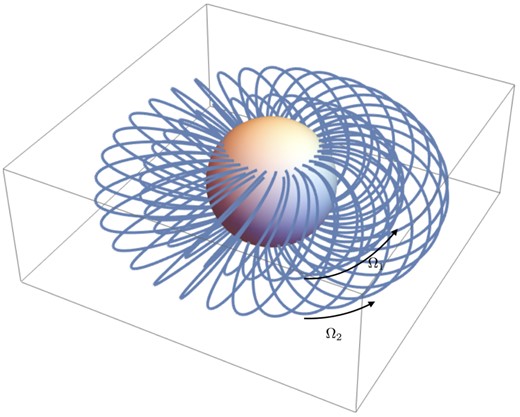
Rotating and twisted magnetosphere without light cylinder. Pictured are magnetic field lines for two flux surfaces. On each flux surface the magnetic field is twisted; in addition flux surfaces are rotating with spin frequency Ω decreasing as a function of maximal radius (equivalently, becoming smaller for smaller polar angles of the foot-points. The magnetosphere is thus composed of onion-like set of nested flux surfaces that rotate each as a solid body, while different surfaces are sheared with respect to each other.

Radial power-law index p as function of the twist parameter C1 for different spins parameters. The dashed line, non-rotating is C2 = 0. Other lines correspond to |$C_2= 0.01,\, 0.1, \, 0.2, \, 0.3$| (top to bottom). Note that for cases when there are no self-similar solutions (e.g. for p smaller than some critical value for each C2 ≠ 0) one may still a have no-light cylinder magnetosphere, but its structure is not self-similar.

Radial power-law index p as function of the rotation parameter C2 for untwisted configuration C1 = 0.

Radial power-law index p as function of the spin parameter C2 for different twist parameters. Beyond the plotted values the index p falls down precipitously.
Note that in the cases when the eigen-problem cannot be satisfied, there may still be solutions with no light cylinder, but those solutions will be non-self-similar. Eventually, for large enough spin the light cylinder will be formed.
In the case of untwisted magnetospheres, C1 = 0, the maximal spin parameter is C2 = 0.34, Fig. 3. We note that finite twists C1 ≠ 0 allow for larger spins, Fig. 4.
Generally, rotation leads to further (in addition to twisting) ‘inflation’ of field lines, Fig. 5. (We stress that inflation here occurs due to the rotation of a flux surface as a whole, not due to the shearing of the foot-points of a given field line).
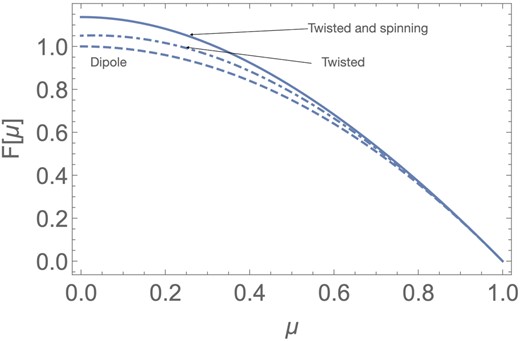
Example that both twist and rotation rotation leads to ‘inflation’ of field lines. The dashed line is for dipole F = 1 − μ2; dot-dashed is for twisted non-rotating case C2 = 0, C1 = 0.66, p = 0.867, solid line is rotating case C2 = 0.1, C1 = 0.66, p = 0.79 (same C1 as non-rotating).
3 SIMULATION
3.1 PHAEDRA code
PHAEDRA code (Parfrey, Beloborodov & Hui 2012) is a pseudo-spectral code developed specifically to study highly magnetized plasma regime, force-free electrodynamics, the vanishing-inertia limit of magnetohydrodynamics (Gruzinov 1999; Komissarov 2006)
Our results further indicate that the code is very stable and efficient, and has low numerical dissipation. The full numerical grid is defined in axisymmetric spherical coordinates and composed of Nr × Nθ cells along the radial and θ directions, respectively. The simulation zone in our work extends from the stellar surface rmin = RNS up to rmax = 100RNS.
3.2 Initialization
3.3 Results
In order to demonstrate that the simulated magnetic field follows the radial scaling predicted by analytics, we plot a time slice of toroidal magnetic field Bϕ at |$\theta =\frac{\pi }{2}$| in Fig. 6 and try to fit it to r−(2 + p). We see that the our radial scaling is in agreement with the analytics.
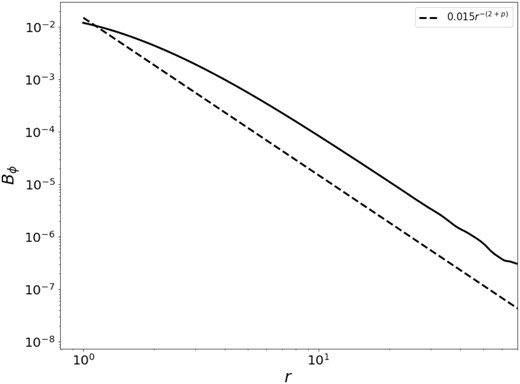
Time slice of toroidal magnetic field Bϕ near the equator for C2 = 0.10, C1 = 0.005, p = 0.9989. The solid line is our simulation results, dashed line is the theoretical expectation r−(2 + p).
In Fig. 7, we plot the scaled azimuthal magnetic field, radial momentum, and the azimuthal velocity for three sets of C1, C2. For C1 = 0.005 ∼ 0 as evident in the top panel, the structure of the rotating magnetosphere clearly matches the analytical result: there are no open field lines, not radial Poynting flux, no energy losses. We see similar structure for the case of C2 = 0.1, C1 = 0.66, p = 0.79 (twisted sheared configuration) in bottom panel.
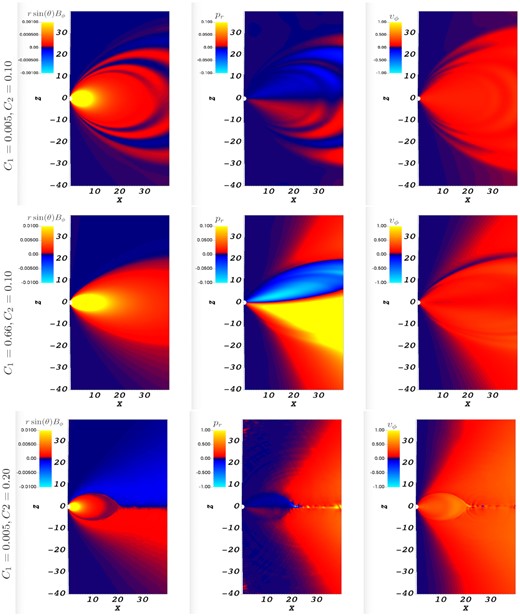
Zoomed-in time slice of our force-free simulation depicting toroidal magnetic field rsin (θ)Bϕ, radial momentum pr, and toroidal velocity vϕ for the fiducial magnetosphere without light cylinder. In top panel we plot C1 = 0.005, C2 = 0.10, p = 0.9989 case, middle panel is for C1 = 0.66, C2 = 0.10, p = 0.79, bottom panel is for C1 = 0.05, C2 = 0.20, p = 0.9854. The radial momentum is the |${\bf E}\times {\bf B}\propto C_2 \sqrt{C_1}$| drift, equation (7). Since Ω ∝ 1/r, equation (10), azimuthal velocity vϕ remains approximately constant with radius, equation (9), top right-hand panels. We do not observe light cylinder in top two rows. At higher spin parameter C2 = 0.2, C1 = 0.05, p = 0.9854 (lower row) the light cylinder can be clearly identified by the location of the Y-point. The wind is generated (this is especially clearly seen in radial momentum pr, central panel.
For small C2 all twisted configuration do not have a light cylinder (first two panels in Fig. 7 and also bottom row in Fig. 8). When we increase the spin parameter C2, the picture changed qualitatively, bottom panel in Fig. 7 (Also see middle row in Fig. 8).
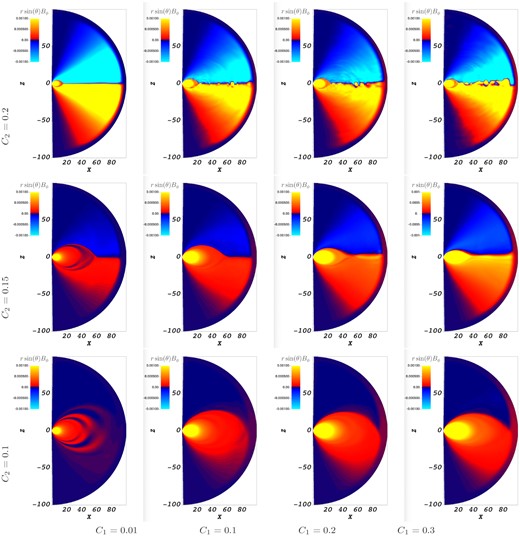
A mosaic of rsin (θ)Bϕ for different twist rotation parameters C1 and C2. C2 = 0.2 (top panel), C2 = 0.15 (middle panel), and C2 = 0.1 (bottom panel). C1 = 0.01, 0.1, 0.2, 0.3 from left to right for both panels at t = 30, measured in light crossing time RNS/c).
To further verify the observations made in previous paragraphs, we plot scaled toroidal magnetic field for various permutations of C1, C2 in Fig. 8.
From the figures, it is clear that the presence of the light cylinder and wind depends strongly on C2. For slow rotation C2 = 0.1 (bottom row) there is no light cylinder. The light cylinder appears near C2 ≥ C2, crit ≈ 0.15. (To guide an eye, formation of the wind requires light cylinder and the corresponding formation of a Y-point. Images with no Y-point imply no wind and no light cylinder.) A more precise critical value of C2, crit could not be determined: at the transition the light cylinder appears at large distances, reaching the absorbing layer next to the outer boundary). For larger C2 ≥ C2, crit the light cylinder is located closer to the star. We restrict our simulations to C2 ≤ 0.3. At this moment the light cylinder is located nearly at the star’s surface, but the relaxation time becomes very long (if compared with small C2 cases).
4 DISCUSSION
We discuss an analytical model of a differentially rotating neutron stars with twisted magnetospheres. We find a new type of solutions without light cylinders. Such configuration could still be a pulsar, a rotating neutron star: it will be more like magnetar producing periodically modulated radio emission driven by magnetic reconnection (Lyutikov 2002, 2020a), not by the rotational energy.
The present model is mostly mathematical. It requires that the twisting motion of the foot-points be comparable to the spin; and the spin shear must be of the particular shape, related to twist. It is a bit surprising that rotating magnetospheres can still be self-similar, since there is a special distance, the light cylinder. Our results indicate that there is a special set of parameters without light cylinder, thus allowing for self-similar solution.
We see the value of the model in that, first, that it provides a clear analytical example of a new types of solutions of the pulsar equation: rotating yet non-spinning down configurations. Secondly, the model might have implication for numerical modelling of twisted, sheared, and rotating magnetospheres of magnetars. Those types of models usually start with stationary neutron star, and then twist, shear, and rotate it. Necessarily, in those simulations the twisting, shearing, and the rotation rate must be similar, as the simulations are limited in their dynamic range: they have to deal with twisting rates similar, just somewhat smaller, to the rotation rate.
ACKNOWLEDGEMENTS
This work had been supported by NASA grants 80NSSC17K0757 and 80NSSC20K0910, NSF grants 1903332 and 1908590. We would like to thank Yiannis Contopoulos, Kyle Parfrey and Alexander Philippov for discussions.
DATA AVAILABILITY
The data underlying this article will be shared on reasonable request to the corresponding author.



